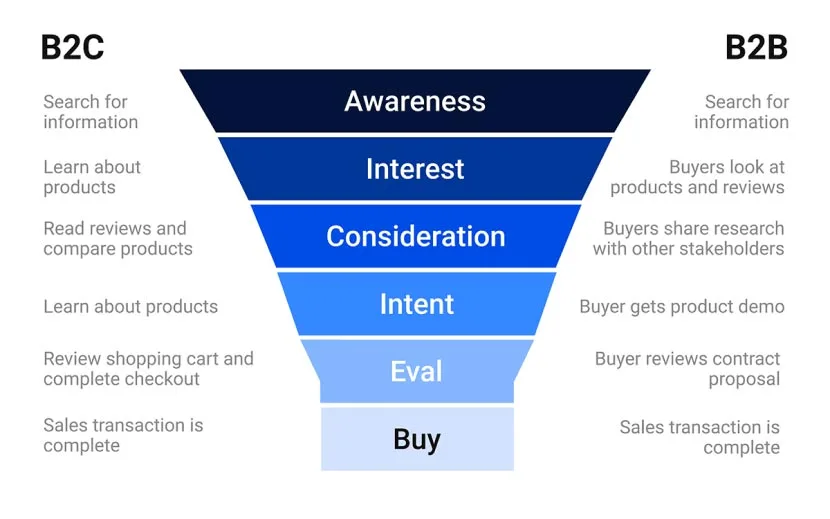The website as the perfect B2B sales channel
In our blog post "WEBSITE AS A DIGITAL VISIT CARD VS. WEBSITE AS A DISTRIBUTION CHANNEL", we have already looked at the benefits of the website as a distribution channel compared to the website as a digital business card. In the following article, we explain what should be considered for a website in order to use it as a sales channel and optimize it along the sales funnel.
Why should I optimize my website as a sales channel?
Let's get straight to the point: It is not always necessary, but in many cases it is nevertheless advantageous, to adapt a company website to the sales funnel and thus, to a certain extent, to the customer's decision-making process.
This is because customers have different interests and needs in the course of their decision-making process. If a website offers the right content for precisely these interests, the user will stay on the website or return to it again and again. This also increases the likelihood of a purchase being concluded on the website.
What is the sales funnel?
But what is a sales funnel anyway? A so-called "funnel" is the English word for funnel and, similar to a funnel, the aim of a sales funnel is to attract the broad masses as interested parties, who then carry out a precisely defined action at the end. Defined actions can be, for example, making contact or making a direct purchase on the website.
What are the advantages of a sales funnel?
A sales funnel is therefore a suitable measure for guiding interested parties along the user journey so that they become customers. But what are the actual advantages of such a sales funnel?
- Good overview
The sales funnel clearly shows the steps of the decision-making process as well as which touchpoints (i.e. contact points) the company has with the prospective customer in which phase. - Easy to measure
This good overview makes it easy to recognize and measure changes, even broken down to the individual phases. This allows both potential and risks to be recognized in good time. - Precise forecasts
The key figures along the sales funnel can also be used to derive sales forecasts. In the event of a negative trend, countermeasures can therefore be initiated at an early stage - before sales actually fall.
How do I optimize my website along the sales funnel?
Now that we have looked at the reasons and advantages of a sales funnel with regard to the use of a website as a sales channel, the question arises as to how exactly a website is optimized along the sales funnel.
- Present product portfolio
In the first step of the sales funnel, potential buyers gather information about different products or services. In order to provide all relevant content at this stage, the product or service portfolio should be presented clearly and with all the necessary information on the company website.This includes, for example, product images, technical details, scope of services, product descriptions and differentiation from other products or services.
- Be found through SEO
In addition to providing all relevant information, it is also important that this information can be found at all. To this end, every company website should be search engine optimized. The better the SEO strategy, the better the company website will rank and the more interested parties will find the content created. - Good UX/UI design
Good design in terms of UX (user experience design) and UI (user interface) ensures better results in every phase of the sales funnel. Information, such as the product portfolio, should be easy to find and easy to consume. - Answer frequently asked questions
With a FAQ page, frequently asked questions can be answered clearly and unambiguously. The questions vary depending on the industry and portfolio and can include anything from "What is the returns process like?" to "How can I get spare parts for my product?". - Best practice examples and customer testimonials
References, best practice examples and customer testimonials are particularly relevant when a prospective customer is considering various alternatives. They show that the company has already successfully implemented similar projects and that the customers were very satisfied with the work or the product. - Contact option
In B2B marketing in particular, personal contact is indispensable, despite digital sales channels. After all, customers don't just spend money on a product or service, they usually make larger and usually long-term investments. It is therefore important to include contact options on the website and offer individual advice. - Strengthen customer loyalty
When converting the website into a sales channel, it is important to consider what happens after the purchase has been completed. After all, retaining customers is usually cheaper than acquiring new ones. To strengthen customer loyalty, a separate area can be created in which content is published that can only be viewed by existing customers.Depending on which products or services a company offers, the individual optimization points can take more or less time. It is important that these are interlinked measures that should always have the needs of potential customers in mind. If these are coordinated and optimized, nothing stands in the way of using a website as a sales channel.

